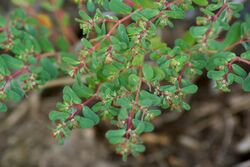Biology:Euphorbia serpyllifolia
| Euphorbia serpyllifolia | |
|---|---|

| |
| Scientific classification | |
| Kingdom: | Plantae |
| Clade: | Tracheophytes |
| Clade: | Angiosperms |
| Clade: | Eudicots |
| Clade: | Rosids |
| Order: | Malpighiales |
| Family: | Euphorbiaceae |
| Genus: | Euphorbia |
| Species: | E. serpyllifolia
|
| Binomial name | |
| Euphorbia serpyllifolia Pers.
| |
| Subspecies | |
| |
| Synonyms[1] | |
| |
Euphorbia serpyllifolia (Euphorbia serpillifolia[note 1]) is a species of euphorb known by the common names thymeleaf sandmat or thyme-leafed spurge. It is native to a large part of North America from Canada to Mexico, where it is a common member of the flora in many types of habitat. This is an annual herb growing as a prostrate mat or taking a somewhat erect form. The oblong leaves are up to about 1.5 centimeters long, sometimes hairy and finely toothed along the edges. The tiny inflorescence is a cyathium about a millimeter wide. It bears scalloped white petal-like appendages arranged around the actual flowers. At the center are several male flowers and one female flower, which develops into a lobed, oval fruit up to 2 millimeters wide. This plant had a number of traditional medicinal uses for many Native American groups.[4]
Subspecies
- Euphorbia serpyllifolia subsp. hirtula is limited to California and Baja California.[5]
- Euphorbia serpyllifolia subsp. serpyllifolia has far wider distribution throughout much of North America with a gap in interior eastern states of the United States.
Uses
The Zuni people use it as a cathartic, an emetic, and to increase the flow of milk in a breastfeeding mother.[6]:51 The leaves are used to sweeten corn meal and chewed for the pleasant taste.[6]:67
Notes
References
- ↑ The Plant List: A Working List of All Plant Species, http://www.theplantlist.org/tpl1.1/record/kew-132410, retrieved 20 August 2016
- ↑ USDA GRIN Taxonomy, https://npgsweb.ars-grin.gov/gringlobal/taxonomydetail.aspx?id=456164, retrieved 20 August 2016
- ↑ McNeill, J.; Barrie, F.R.; Buck, W.R.; Demoulin, V.; Greuter, W.; Hawksworth, D.L.; Herendeen, P.S.; Knapp, S. et al. (2012), International Code of Nomenclature for algae, fungi, and plants (Melbourne Code) adopted by the Eighteenth International Botanical Congress Melbourne, Australia, July 2011, Regnum Vegetabile 154, A.R.G. Gantner Verlag KG, ISBN 978-3-87429-425-6, http://www.iapt-taxon.org/nomen/main.php?page=title
- ↑ "BRIT - Native American Ethnobotany Database". http://herb.umd.umich.edu/herb/search.pl?searchstring=Chamaesyce%20serpyllifolia.
- ↑ Jepson Manual: ssp. hirtula
- ↑ 6.0 6.1 Stevenson, Matilda Coxe 1915 Ethnobotany of the Zuni Indians. SI-BAE Annual Report #30
External links
Wikidata ☰ Q5410571 entry
 |

